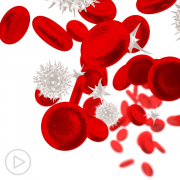Understanding Treatment Options for ET, PV, and Myelofibrosis
Understanding Treatment Options for ET, PV, and Myelofibrosis from Patient Empowerment Network on Vimeo.
MPN specialist Dr. Jeanne Palmer discusses the treatment options available for essential thrombocythemia (ET), polycythemia vera (PV), and myelofibrosis (MF). Dr. Palmer explains how a treatment choice is determined for each of the MPNs and how anemia is managed in patients with myelofibrosis.
Dr. Jeanne Palmer is a hematologist specializing in myeloproliferative neoplasms (MPNs) and bone marrow transplant at the Mayo Clinic in Arizona. Dr. Palmer also serves as Director of the Blood and Marrow Transplant Program and is Vice Chair and Section Chief for Hematology. Learn more about Dr. Palmer, here.
Related Programs:

When Should Stem Cell Transplants Be Considered for MPN Treatment? |

|

|
Transcript:
Katherine Banwell:
Much of the time the chosen treatment for MPNs manages the symptoms of the condition. I’d like to review the different types and classes of treatment for the three MPNs. So, let’s start with essential thrombocythemia again. When is it time to treat, and what are the options available?
Dr. Jeanne Palmer:
Right. So, with essential thrombocythemia, that’s the disease that sometimes we don’t need to treat.
So, we basically have a risk stratification system and this risk is based on age, history of a blood clot, the presence or absence of a JAK2 mutation. So, for example, if somebody is 28, does not have a JAK2 mutation, which is again one of those driver mutations, and never had a blood clot, they actually don’t necessarily need to do anything and just be monitored.
Somebody who is less than 60 and has a JAK2 mutation or who is greater than 60 and does not have a JAK2 mutation, in that setting, a lot of times you can use aspirin. Now, it gets a little bit gray in terms of that over 60 without the JAK2 mutation with regards to whether at that point you really should start taking some medicine to lower the platelets.
Now, if somebody has a JAK2 mutation, is greater than 60 or has had a blood clot, hands down they need to take medicine to lower the platelets, in addition to aspirin or whatever blood thinner they may need. So, for example, if you have a blood clot in a vein, a lot of times you need to take a blood thinner and that will be a lifelong thing. And again, we do these risk stratifications because we know there is a certain risk of clotting associated with the risk of essential thrombocythemia.
So, for example, somebody who is less than 60 and does not have a JAK2 mutation, never had a clot, their risk of clotting is probably very close to that of the normal population. Whereas if you’re higher risk and have a JAK2 mutation and greater than 60 or have had a history of a clot, the risk of clot is probably about 4 percent per year. So, this is something that can vary quite widely, and even though that 4 percent per year on the short-term doesn’t sound like a lot, if you take it additive over years, that’s why we generally try to be aggressive about lowering the platelets.
In lowering the platelets, the goal is to get less than 400 and doing that can be done through several different medications. The most commonly used medications is a drug called hydroxyurea, which has been around for a number of years, and a drug called anagrelide which is probably a little less commonly used, because it has some more GI side effects and headaches associated with it.
In some cases, especially in younger patients with this disease, we can consider using interferon, which is an injection of a cytokine, which are one of the chemicals that regulates the immune system within the body. But this interferon can actually help lower the platelets and there is a question of whether it may affect the biology of the disease as well.
Katherine Banwell:
Let’s turn to polycythemia vera or PV, what are the different options available for treating it?
Dr. Jeanne Palmer:
So, for polycythemia vera, everyone needs to be on aspirin.
And additionally, everyone needs to make sure to keep their blood count low, to manage their hematocrit, which is one of the measures of red blood cells. So, in men it’s generally recommended to keep below 45 and in women it’s recommended to keep below 42 percent. Now, the studied number was 45 percent and that was a study that was done, I don’t know, it was probably about 10 plus years ago, that actually showed that by keeping the blood hematocrit less than 45 percent you reduce the risk of having negative events like cardiovascular events and heart attacks. Because women tend to run with a lower blood count than men, it’s been extrapolated that 42 percent should be the number used for women.
Now, this can be done by phlebotomy, which essentially is bloodletting.
It’s kind of like donating blood except for that the blood unfortunately can’t be donated to anybody, it has to be discarded. But the phlebotomy is one way to do that, and the reason that works is because it makes somebody iron deficient. So, whereas if this is normal, if you’re iron deficient you become anemic. If your baseline hematocrit is here, making you iron deficient brings you back to normal. So, even though we always associate iron deficiency with anemia, iron deficiency in the setting of polycythemia vera is actually kind of a treatment of sorts.
Now, once somebody gets above 60 and 60 seems to be sort of the magic age in these diseases, once somebody gets above 60, it is recommended that cytoreductive therapy is used, which means therapy or treatment that will bring down the red count. And again, for this one, hydroxyurea is an option as well as interferon. And there is recently an approval, actually FDA approval for a newer interferon called ropeginterferon or Besremi, which can help just bring down the red blood cells but it is the first interferon that’s actually been FDA approved for this indication.
Katherine Banwell:
Are JAK inhibitors used as well?
Dr. Jeanne Palmer:
They are. So, if somebody doesn’t respond well to hydroxyurea, the approval for ruxolitinib is actually for patients who have failed hydroxyurea. Although it’s something that we often consider especially in people who have a lot of symptoms. So, the itching, one of the things that can really help itching actually is Jakafi. If people have night sweats, they have weight loss, spleen related symptoms, those are the patients that will benefit from Jakafi. Additionally, if they are on hydroxyurea and can’t seem to get control of their blood count, Jakafi is a good option to help control the blood counts as well.
Interferon is a very nice option because there’s great data that shows that you may actually be able to lower the percentage of JAK2 burden.
So, we’d look at something called an allele burden, which is the percentage of cells that are involved – have the JAK2 mutation. Now, we don’t know whether lowering this percentage necessarily translates to long-term better survival, but I think there is enough data out there, and there is a good biologic underpinning for saying that this actually can help. But yes, Jakafi is another thing.
And the really exciting thing is that there is a newer agent called rusfertide, which is a hepcidin mimetic, which is basically taking a protein in your body that helps metabolize iron and by making it externally and giving it to somebody that it can actually help bring down the hematocrit without having some of the other side effects we know with some of the other medications. That is currently in Phase III studies, so hopefully in the next couple of years we’ll see approval for that.
Katherine Banwell:
Oh, that’s great news. And finally, how is myelofibrosis treated?
Dr. Jeanne Palmer:
So, myelofibrosis is a little bit of a different animal. When you have something like essential thrombocythemia or PV, a lot of this is managing symptoms, preventing blood clots, but if you do appropriate treatment and management of these diseases you could probably live close to a normal life expectancy.
So, I never typically pin a survival on it. With myelofibrosis, it’s a little bit different because there is a survival. Instead of saying you can live close to normal life expectancy, it backs up to saying how many years do I think you can live with this disease. Now, of course, we are horrible at predicting how many years anyone can live, so we have to take that all with a grain of salt. But we can at least sort of risk stratify people.
And the first thing that’s really important is to figure out whether somebody is a transplant candidate or not and if, based on age, disease risk features, stuff like that, or whether we think they ever will be a transplant candidate. So, that kind of helps us sort of think about what your path moving forward is.
Now, the current FDA-approved treatment for myelofibrosis, there are three JAK inhibitors approved, which is like Jakafi, which was the first approved one but there is also Inrebic or fedratinib and Vonjo or pacritinib and these have all been approved over the years.
The role of JAK inhibitors and treatment of myelofibrosis is symptoms-based. So, for example, a lot of patients with myelofibrosis will have weight loss, night sweats, big spleens, really feeling fatigued and poorly and in this setting, the JAK inhibitor can be very helpful. And you don’t have to have a JAK2 mutation, a lot of times people say, well, I don’t have the JAK2 mutation so how can a JAK inhibitor help. So, the JAK inhibitor works on this pathway, which is called the JAK/STAT pathway, irrespective of mutation.
So, if you are having symptoms and you have myelofibrosis, JAK mutation, excuse me, the JAK2 mutation does not predict who is going to have a response. And people who, regardless of which mutation you have, may actually benefit from it.
So, the JAK inhibitors, though, are extremely effective at reducing symptom burden as well as reducing the spleen size. And we know that if a spleen is big and we can make it shrink that, that probably is a surrogate marker for living longer, and I think it’s because inflammation does a lot of wear and tear on the body. So if you can reduce the inflammation and the spleen shrinks, which generally go hand in hand, then you might help somebody live longer. It is not changing the biology of the disease, though, however, it doesn’t change the pathway and that this disease is kind of projecting ahead in terms of creating – it changes, as it goes along, may acquire new mutations or something like that which makes the disease become more serious.
Right now, the approved therapies for it are JAK inhibitors and the Jakafi, ruxolitinib was the first one approved. Inrebic was approved several years back, or fedratinib.
And then the most recent one that was approved is Vonjo or pacritinib and that’s a drug that is a JAK inhibitor that is actually very good for people with low platelets. The reason I bring that up is because if we think of what’s the biggest limiter of JAK inhibitors, JAK inhibitors bring down red blood cells, and they bring down platelets. So, when somebody has low platelets it’s very hard to use a JAK inhibitor, because we’re not really able to increase the dose well enough to get that inflammatory reduction because of the fact that the blood counts will drop too low.
So, now drugs like Vonjo exist which, due to several other mechanisms associated with the drug are actually much more tolerated in somebody with low platelets. So, if you have low platelets, you can actually take the Vonjo, hopefully get the same degree of JAK inhibition to help the spleen shrink, help the symptoms get better without necessarily making the platelets substantially worse. A lot of times they do drop, it doesn’t help bring up the platelets, but it does help people tolerate more JAK inhibition, which ultimately will help with symptoms.
Dr. Jeanne Palmer:
So, one thing I also wanted to add about myelofibrosis treatment is sometimes people present, they don’t have a lot of symptoms, they don’t have a lot of spleen related problems but they have anemia or low blood counts and these can be incredibly hard to treat.
Even with symptoms and low red blood cell count or anemia or low platelets, it can be challenging to treat because many of these medications lower that. To treat the anemia there are several things that we can do. One of the first ones is using erythropoietin, and so there are many agents, they go by the names of like Procrit or darbepoetin alfa (Aranesp), that actually stimulate red blood cell growth by – like we give a recombinant hormone that helps red blood cells grow. This is normally something produced by the kidney.
So, one thing that’s important before going on one of these injections is to make sure that the kidney is not already producing enough. So, for example, if the kidney said, oh geez, I really need more red cells and is making lots of this hormone, erythropoietin, giving more of it is not going to help the system. But in people who don’t have a really high level it can be very beneficial.
The other thing that can help with anemia, specifically, is a drug called danazol.
It’s been around for a very long time. There are multiple presumed mechanisms of action, but one of them is that it is kind of a testosterone derivative. So, this is a medicine that can often help increase red blood cells in probably about 40 percent of people, and it’s a pill that you take twice a day.
Another option, sometimes we use thalidomide or lenalidomide (Revlimid). These are medications that have been used quite frequently in the setting of multiple myeloma and even a little bit in myelodysplastic syndrome, so some other blood disorders.
But in the setting of myelofibrosis, they can be helpful with anemia and sometimes are combined with prednisone or a corticosteroid.
And then finally, in terms of drugs that are being tested and hopefully will be approved at some point in the future. There is a drug called momelotinib, which is another JAK inhibitor that actually has some mechanisms that may also help improve hemoglobin.
So, this is something I’m really looking forward to and we anticipate may be approved by the end of the year. And finally, there is another drug called luspatercept. Luspatercept may work in the setting where your kidneys are already producing enough erythropoietin. So, the luspatercept is an injection that you receive once every three weeks.
It is currently FDA-approved for the treatment of myelodysplastic syndrome but this is something that has been shown to have some efficacy in myelofibrosis as well. So, this could be another therapeutic option for patients with myelofibrosis.
It is also important, especially for people who have polycythemia vera myelofibrosis to make sure that your iron has been checked and B-12 has been checked, because just because you have a bone marrow disorder doesn’t necessarily mean you don’t have a nutrition deficit that may be able to help improve your hemoglobin somewhat. But these are important things to talk to your doctor. I do not recommend just starting to take iron or B-12, however, if you’re anemic because in many cases you are not deficient and taking too much iron can actually be damaging.
Katherine Banwell:
Yeah, that’s great advice.










